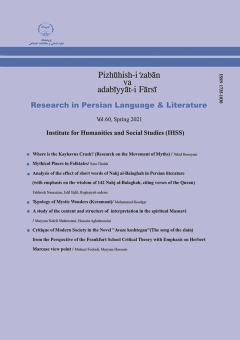-
-
List of Articles
-
Open Access Article
1 - Where is the Kaykavus Crash? (Research on the Movement of Myths)
vahid rooyani -
Open Access Article
2 - mythical places in folktales
Sara Chalak -
Open Access Article
3 - Analysis of the effect of short words of Nahj al-Balaghah in Persian literature (with emphasis on the wisdom of 142 Nahj al-Balaghah, citing verses of the Quran)
Fakhrieh Namazian Jalil Tajlil Ruqayyah Sadraie -
Open Access Article
4 - Classification of the Kramat of Olia
Mohammad Roodgar -
Open Access Article
5 - A study of the content and structure of interpretation in the spiritual Masnavi
Maryam Nafeli Shahrestani hosein aghahoseini -
Open Access Article
6 - The"Avaze koshtegan"(The song of the slain), from the view of the Critical Theory of the Frankfurt School, with Emphasis on the Theories of Herbert Marcuse Critique of Modern Society in the Novel of the
Mahnaz Fooladi maryam hoseini
-
The rights to this website are owned by the Raimag Press Management System.
Copyright © 2017-2025







